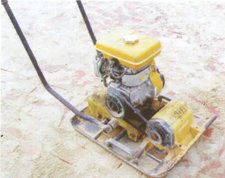Laying should be commenced from a starting edge on the prepared bedding course in the desired laying pattern. The first few rows of pavers should be laid carefully. Initial care will ensure that the laying that proceeds true to line and pattern. Alignment should be checked from time to time during the laying process, so that simple adjustments can be made to assure a clean, consistent bond pattern throughout the process.
To ensure a harmonized appearance, it is always a good practice to select pavers from three or more packs randomly. A Code of Practice for design of flexible clay paver is given in BS 6677: Part 2 for design of light traffic pavements, and BS 6677: Part 5: 1986 for Method for Construction of Pavements.
Joints
Care should be taken during laying to ensure that a space of 3 to 5 mm is left and no point contact exists between adjacent pavers in order to reduce the risk of edge chipping. The space should be filled with dry, clean fine sand to form finished joints thus providing interlocking effect. Complete joint filling with correct type of sand is essential for effective interlock and shear transfer. The sand should comply with grading F as defined in BS882: 1983. Dry evenly fine graded sand can be spread over the pavement and brushed into the joints before compaction begins.
 Compaction Compaction After laying onto the prepared sand bed and joints filling with sand, pavers should then be compacted into position by two or three passes of vibrating plate compactor fitted with a neoprene pad (picture on the right). As recommended in BS 6677: Part 3, the plate area should be at least 0.20 m2. it should transmit an effective force of 50-75 kN/m2 at a vibration frequency of between 60 and 100 Hz. Compaction should not be performed closer than one meter from any unrestrained edge. Further sand should then be applied and the procedure repeated.
Edge Restraints for Paved Areas
A rigid edge restraint along the perimeter of the paved area is necessary to prevent lateral movement of the paving units leading to subsequent lost of interlock and to retain the bedding course sand. Concrete, stone, metal, some types of plastic or a soldier course of mortared brick set in concrete can serve as an edge restraint. The border can be planned not only to complement the design of the pavement, but also to provide a channel for surface runoff. Pavement accessories can be used to create elegant curbing for your paving project while also act as an edge restraint.
Edge restraints should be formed before compacting adjacent units and the restraints, together with any concrete haunching, should be mature before vibration of the surface course is undertaken. Haunching to an edge restraint should be continued down to the level of the underside of the bedding course. Where appropriate, drainage should be provided at edge restraints to prevent building up of a head of water in the bedding course. |